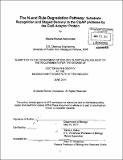The N-end rule degradation pathway : substrate recognition and staged delivery to the CIpAP protease by the CIpS adaptor protein
Author(s)
Román Hernández, Giselle
DownloadFull printable version (14.34Mb)
Alternative title
Substrate recognition and staged delivery to the CIpAP protease by the CIpS adaptor protein
Other Contributors
Massachusetts Institute of Technology. Dept. of Biology.
Advisor
Tania A. Baker.
Terms of use
Metadata
Show full item recordAbstract
Regulated protein degradation is crucial in the regulation of many physiological processes as well as in protein quality control. In all organisms, ranging from bacteria to mammals, ATP-dependent proteases carry out regulated protein degradation in order to maintain homeostasis as well as to respond to stress. ATP-dependent proteases are responsible for the degradation of a broad array of substrates and for that reason, a high degree of substrate specificity is required in order to target only desired proteins for destruction. Adaptor proteins can provide ATP-dependent proteases an extra-layer of specificity by binding and delivering a specific class of substrates, therefore regulating the activity of the protease. Understanding how adaptor proteins work in combination with their partner protease will provide a better understanding on how specificity is achieved by these proteolytic machines. In this thesis, different aspects of the bacterial N-end rule degradation pathway are examined. The N-end rule is a highly conserved degradation pathway that relates protein stability to the identity of its N-terminal residue in both prokaryotes and eukaryotes. For example, in bacteria, Tyr, Phe, Trp, and Leu serve as degradation signals when located at the N-terminus of a protein. In E. coli, the bacterial adaptor CIpS recognizes these signals and delivers these substrates to the AAA+ protease CIpAP. Here, we present the first crystal structure of a bacterial N-end rule adaptor, CIpS, bound to a peptide mimic of an N-end rule substrate. This structure pioneered the understanding behind the basis of N-end rule recognition by CIpS. The CIpS structure reveals the adaptor recognizes the peptide a-amino group via hydrogen bonding and shows that the peptide's N-terminal side chain is buried in a deep hydrophobic cleft that preexists on the surface of CIpS. We also present here the crystal structures of CIpS alone and engaged with peptides containing the rest of the primary N-end degrons (N-terminal phenylalanine, leucine, and tryptophan). These structures, together with the first structure of CIpS bound to an N-terminal tyrosine, illustrate the molecular basis of recognition of the complete set of primary N-end rule residues. Moreover, we show that mutation of critical CIpS contact residues impairs substrate delivery to and degradation by the AAA+ protease CIpAP. In addition to the structural studies, the biochemical studies presented here provide a better understanding on how CIpS and CIpA work together for efficient N-end rule substrate delivery. Here, we show that substrate binding is enhanced substantially when CIpS binds ClpA6. Reciprocally, N-end-rule substrates increase CIpS affinity for CIpA6. Some of the features required for enhanced binding include the substrate N-end residue and the substrate first peptide bond. It also requires multiple features of CIpS, including a side chain that contacts the substrate a-amino group and two regions of a flexible N-terminal extension (NTE). We also show that enhancement in affinity requires the N domain and AAA+ rings of CIpA to be connected by a sufficiently long linker. One major novel finding uncovered in this thesis is that the CIpS NTE can be engaged by the CIpA translocation pore, but CIpS resists unfolding/degradation. We propose a staged-delivery model that illustrates how intimate contacts between the substrate, adaptor, and protease reprogram specificity and coordinate handoff from the adaptor to the CIpAP proteolytic machine.
Description
Thesis (Ph. D.)--Massachusetts Institute of Technology, Dept. of Biology, June 2011. "June 2011." Cataloged from PDF version of thesis. Includes bibliographical references (p. 158-165).
Date issued
2011Department
Massachusetts Institute of Technology. Department of BiologyPublisher
Massachusetts Institute of Technology
Keywords
Biology.